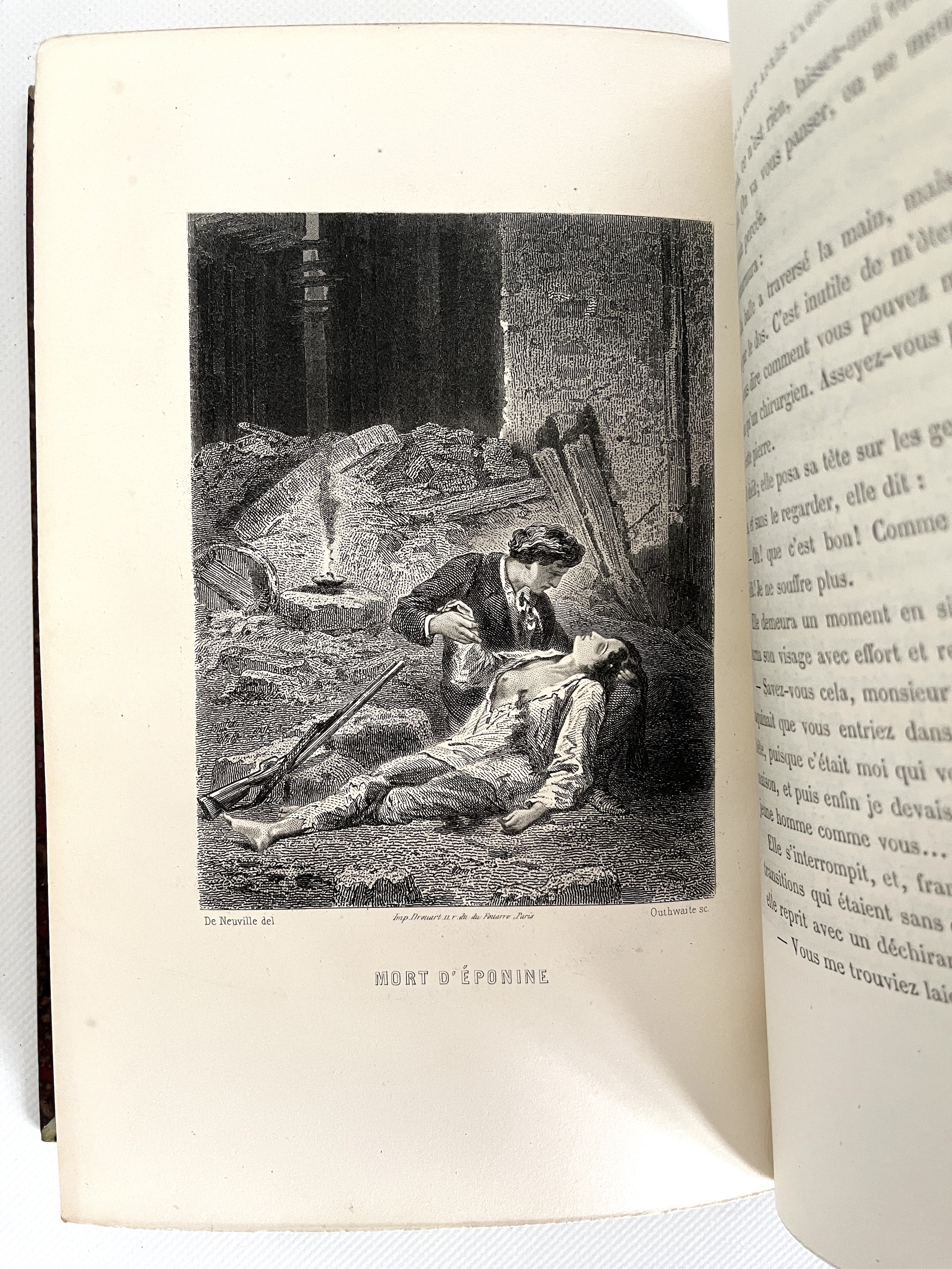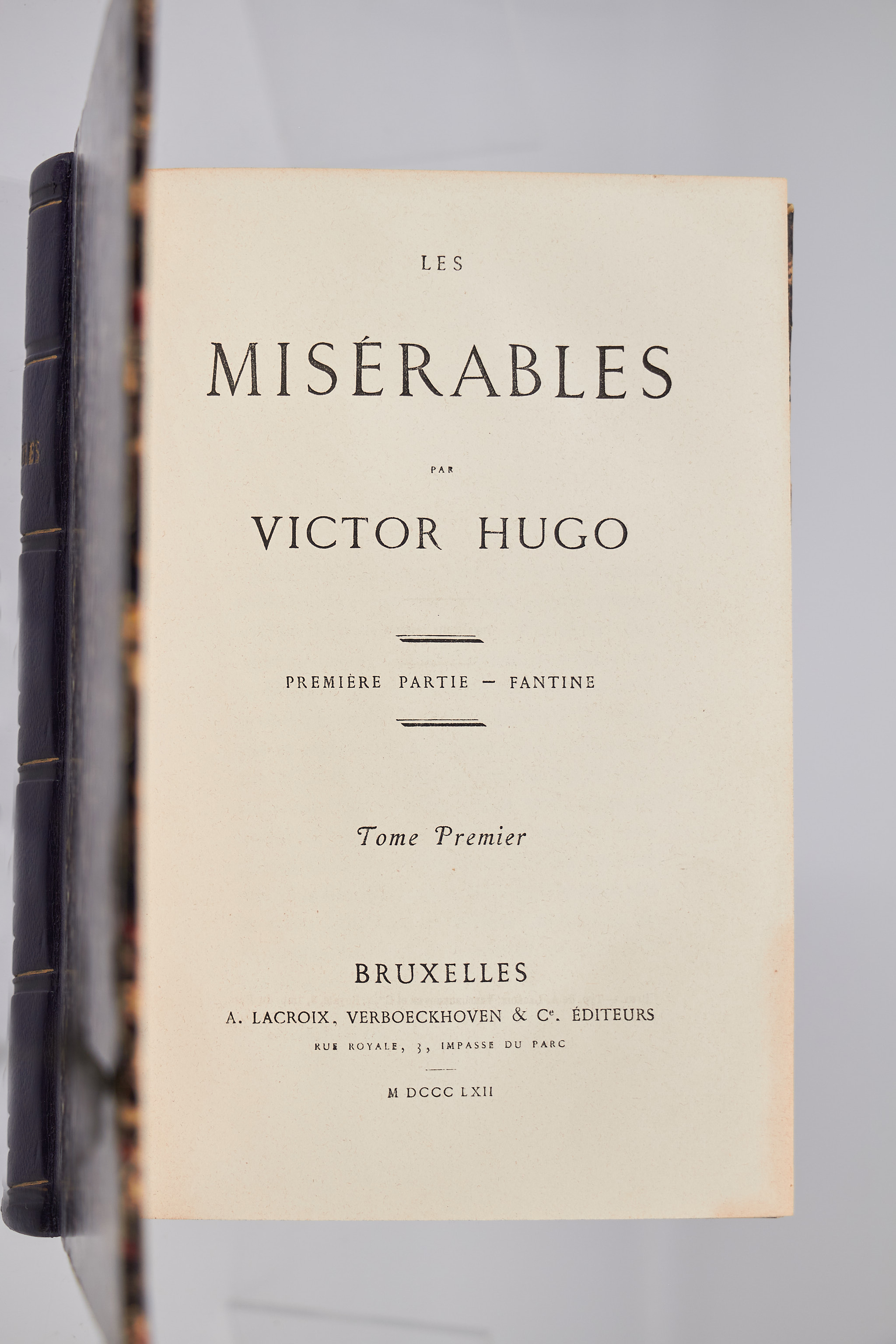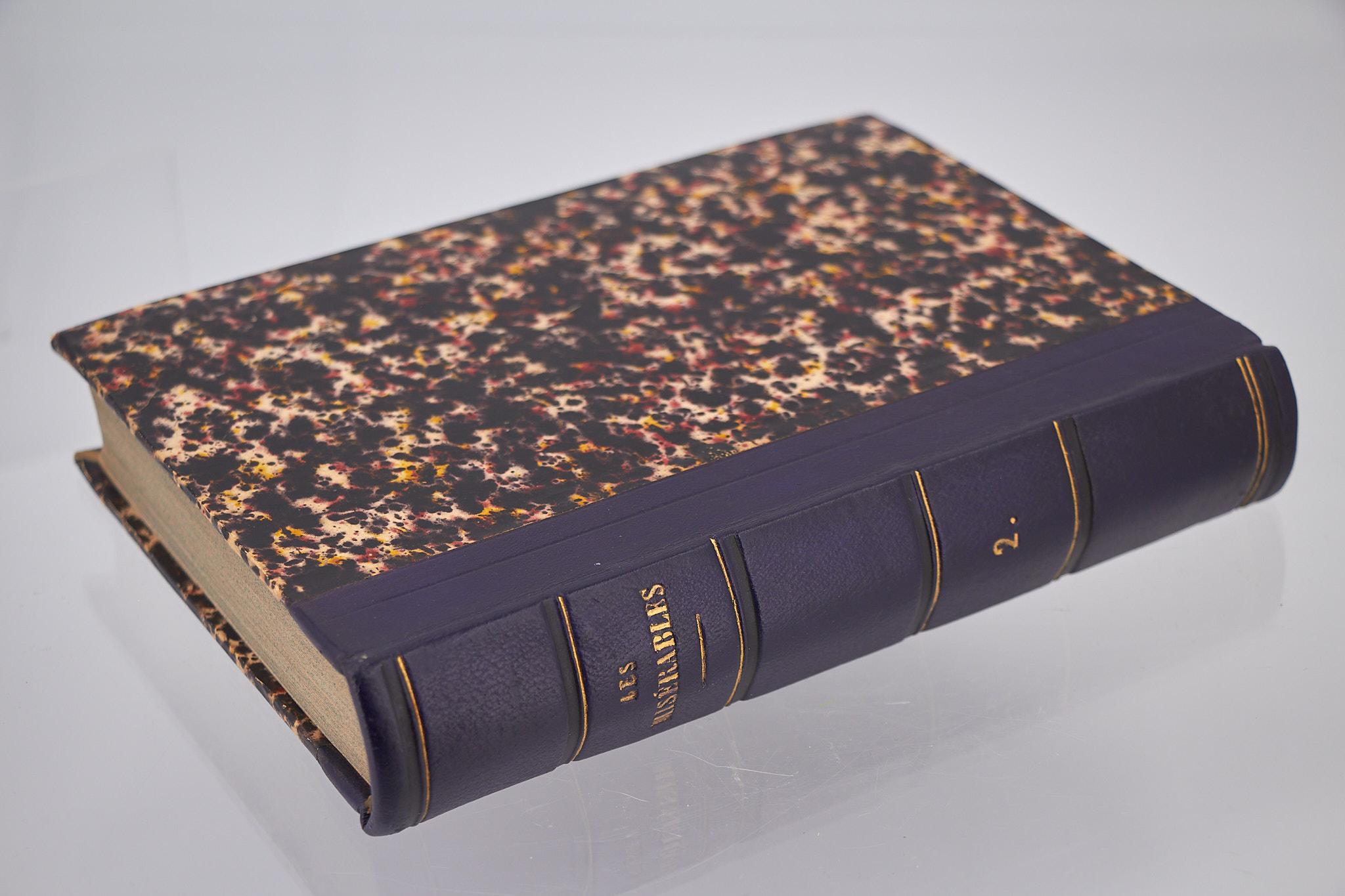The first edition of Les Misérables was legally created by three different publishers, Pagnerre in France, Lacroix in Belgium and Steinacker in Germany, under the aegis of the official publisher A. Lacroix, Verboeckhoven & Cie.
The question of the prevalence of one edition over the other, between the two first edition published on 1862, April, 3, in Bruxelles and Paris simultaneously, has long stirred the bibliophilic world and bibliographers remain divided on this thorny issue. Carteret and Vicaire, for example, ensured that the Paris edition should be preferred, whereas Vanderem and Clouzot placed the Belgian edition first. More than just a matter of chronology, this bibliographical dispute reveals the complexity of the concept of the first edition and the symbolic importance its holds for literary history and, in particular, for this masterful work which is among the most important in world literature.
Strangely, without this question really being settled, the Brussels edition is commonly described as pre-Paris, whereas the Leipzig edition is simply ignored. Les Misérables would, therefore, be published on 30 or 31 March with Lacroix and 3 April with Pagnerre.
The arguments of this Belgian precedence are, however, all refutable, and from 1936, Georges Blaizot had demonstrated its fragility.
The first argument is based on a letter by Victor Hugo addressed to Lacroix from 1865 and in which the poet himself called the Belgian edition “princeps” “first”: “Typographiquement, il faut se régler en tout sur l'édition belge princeps des Misérables, en dilatant plutôt qu'en resserrant” “Typographically, it is necessary to be totally attuned with the first Belgian edition of Les Misérables, expanding rather than tightening” he wrote on the subject of the Travailleurs de la mer which will be published in 1866. Yet, Hugo's designation is by no means a bibliographical indication, as Georges Blaizot explains, denouncing the abusive interpretation of P. de Lacretelle and Dr Michaux :
« Le poète précise un point, un seul, très simple, très clair, très précis : l'édition belge princeps (c'est-à-dire la première parue des éditions belges) doit servir de type aux éditions futures. Il dit cela, il dit bien cela, il ne dit que cela. »
“The poet specifies one point, one, very simple, very clear, very precise: the first Belgian edition (i.e. the first published of the Belgian editions) must serve as a type for future editions. He says that, he says that clearly, he says only that.” (Georges Blaizot in Le Bulletin du bibliophile et du bibliothécaire, 1936).
Indeed, a more modern in-12 edition will follow the famous in-8 edition in October of the same year.
The second argument is more significant. It is based on a letter by Adèle Hugo to her husband recounting the extraordinary affair of the French publication four days before the scheduled date.
This letter will be partially reproduced in 1904 in the complete works published by Meurice and Simon, with the supposed date of “[31 March 1862]”. In it, Adèle recounts the reasons for the French publishing haste: “Auguste [Vacquerie] nous apprend que Les Misérables paraissent sous trois jours. Étonnement mêlé de satisfaction. Auguste me raconte qu'ils comptaient faire paraître Les Misérables le 7 avril ; que le matin [Noël] Parfait était accouru effaré chez [Paul] Meurice lui dire qu'il sortait de voir aux mains de [Paul] Siraudin, un exemplaire des Misérables qu'il avait acheté la veille à Bruxelles.” “Auguste [Vacquerie] tells us that Les Misérables will be published in three days. Astonishment mixed with satisfaction. Auguste tells me that they intended to publish Les Misérables on 7 April; that in the morning [Noël] Parfait had run in alarm to [Paul] Meurice to tell him that he went out to see a copy of Les Misérables in the hands of [Paul] Siraudin that he had bought the day before in Brussells.”
This testimony and the dating of the letter in these publisher's notes are no doubt at the origin of the assertion that the Belgian publication came first. In fact, it is undeniable that on this date, the French edition has not yet been published since the printer Claye will not deposit the two Parisian volumes at the National Archives until the next day, 1 April 1862. The Lacroix edition would therefore, in this sense, be the true “first”.
Adèle's letter was not, in fact, written on 31 March, but over three days: “commencée dimanche (donc le 30 mars) et finie aujourd'hui [mardi] premier avril” “started Sunday (therefore 30 March) and finished today [Tuesday] first of April”. She would therefore assume the existence of paper bound volumes in Brussels from 29 March (and certainly not on 30 March, which was a Sunday). Yet, at the same time, Hugo and Lacroix were in the midst of epistolary negotiations to settle this delicate issue of the next publication date:
« Mon cher maître, écrivait Lacroix le 30 mars, nous avons tout combiné pour le 4 avril, (…) il faut qu'à Paris l'ouvrage paraisse aussi cette semaine ».
“My dear sir, Lacroix wrote on 30 March, we have everything together for 4 April, [...] the work must also be published in Paris this week”.
De son côté Hugo, le 1er avril, avertissait son éditeur :
« on prétend que le livre qui ne peut (…) paraître à Paris que le 7, paraîtra le 3 partout ; de sorte que Paris, cœur du succès, serait servi le dernier. Ce serait là une faute incalculable. Paris servi après tout le monde, c'est le succès attaqué à sa source ».
“it is claimed that the book, which cannot [...] be published in Paris until the 7th, will appear everywhere on the 3rd; so that Paris, the heart of success, would be served last. This would be an incalculable mistake. Paris served after everyone else is attacking success at its source”.
While in Paris, Meurice, Vacquerie and Pagnerre speed up the French publication to counter the Belgians who “ont tenté de jouer un tour” “tried to play a trick” on the French, as Adèle reports to her husband, in Guernsey; Hugo raises the tone with his publisher by hammering home the importance of the French edition: “ la simultanéité, bien ; mais s'il devait y avoir une priorité, c'était pour Paris” “simultaneity, fine; but if there were to be a priority, it would be Paris”.
What about the Brussels publication in March? There is no other mention, other than Siraudin's affair (told by Adèle who takes it from Vacquerie recounting Parfait's words to Meurice) that seriously confirms this theory. The Belgian newspapers, the Parisian clan's main concern: “les journaux de Paris ne se soucieraient pas d'annoncer ce livre […] après les journaux belges et de devenir leur déversoir et leur succursale” “the Paris newspaper would not worry about announcing this book [...] after the Belgian newspapers and becoming their outlet and their branch”, did not yet form any link to this highly anticipated book, other than Indépendance Belge which announced in turn on 30 March: “En vente chez tous les libraires” “For sale in all bookshops” and on 1 April: “Demain paraît enfin la première partie des Misérables” “Tomorrow the first part of Les Misérables is finally published”. In accordance with Hugo's editorial strategy, the first extracts of the work will not be published until 2 April, notably in Le Temps, which the day before announces the simultaneous publication in France and Belgium on 4 April, and in Le Journal des Débats, where the article signed Jules Janin was in fact written by Meurice, due to the urgency described by Adèle: “Je ne puis parler du livre ce soir puisque je ne le connais pas, dit Janin, faites vous-même la chose, Meurice.” “I cannot speak about the book this evening since I don't know it, said Janin, do it yourself, Meurice.”.
Was there then really a Belgian publication in March, or were the few copies that probably circulated before the official and simultaneous publication in France and Belgium an isolated and insignificant accident? Studying Hugo's correspondence shows that as a result of a bad “trick” by the Belgians, it is simply a question of a confusion of dates attributable to... Victor Hugo himself. It is indeed Hugo who sent false intentions of simultaneous publication on 7 April to Vacquerie and Meurice, while he had rushed Lacroix for everything to be ready on 4 April. Thus, he sowed doubt and misunderstanding among the two publishers. (cf. Bernard Leuilliot, Victor Hugo publie les Misérables, p. 240)
The first two volumes, titled Fantine, will finally go on sale on 3 April, in France, Belgium, and also in Germany, and in several other countries that received copies printed by Lacroix. Probably, it was one of these advance paper bound copies to be shipped to Latin America that Siraudin obtained. Lacroix informed Hugo precisely on 30 March: “tout est tiré, tout était broché et les expéditions pour l'étranger en partie faites” “everything is printed, everything was paper bound and the shipments for foreign countries in part made”.
There is therefore no reason to assume any anteriority from one edition to the other. And it is in perfect harmony that Adèle, Charles, Paul de Saint-Victor, Vacquerie, Lacroix and Pagnerre will celebrate, on the evening of 3 April at Meurice's,
“ l'éclatante victoire simultanée en tous pays, le jour même de la mise en vente à Paris, à Bruxelles, à Londres, à Milan, à Naples, à St. Pétersbourg”
“the brilliant simultaneous victory in all countries, the very day of release in Paris, in Brussels, in London, in Naples, in St. Petersburg” as Lacroix writes that very evening to the writer who had just become part of publishing history.
The success is such for these first two volumes that, as Victor Hugo feared, the Pagnerre's print run (6,000 copies according to Hovasse and 7,000 according to L.C. Michel in la revue anecdotique on 15 April 1862) sold out very quickly: “Le 6, on eût battu toutes les librairies de la rive gauche et de la rive droite, pour en trouver un exemplaire” “On 6 April, we would have scoured all the bookshops on the left bank and the right bank to find a copy”. Therefore, 1,000 copies of the 5,000 copies for Brussels intended for the Belgian and foreign market were obtained to create a false French “second edition”, which is in reality the Belgian first edition with a new title page. However, from 10 April, Pagnerre is obliged to undertake a new print run, which will be ready on the 17th thanks to the imprints carefully produced by the printer Claye during the first print run. Only the title pages were produced “on the mobile” in red and black with antique capitals “un des joyaux de son matériel typographique” “one of the jewels of its typographic material”. In all, if we are to believe the probably overly optimistic figures (according to Hovasse) from La Revue anecdotique and the publishers' correspondence, the different print runs of this first part will be almost 15,000 copies at the Parisian address and 12,000 at the Brussels address, with the addition of 3,000 copies printed in Leipzig at Steinacker. The latter, published in small format, also from 3 April, would undoubtedly deserve greater attention, because in addition to participating in the first editions, they respond to an urgent request from Hugo to immediately offer an inexpensive edition to allow everyone to access his work, such as the one introduced by Lacroix shortly after. On the other hand, the second and third parts will be published with a slight delay, on 15 May in Paris, and between 16 and 19 May in Brussels, due to an unfortunate steam engine accident (cf. letter from Lacroix to Hugo on 11 May 1862). Fortunately, on 30 June, Brussels and Paris will be perfectly synchronised to publish the last four volumes.
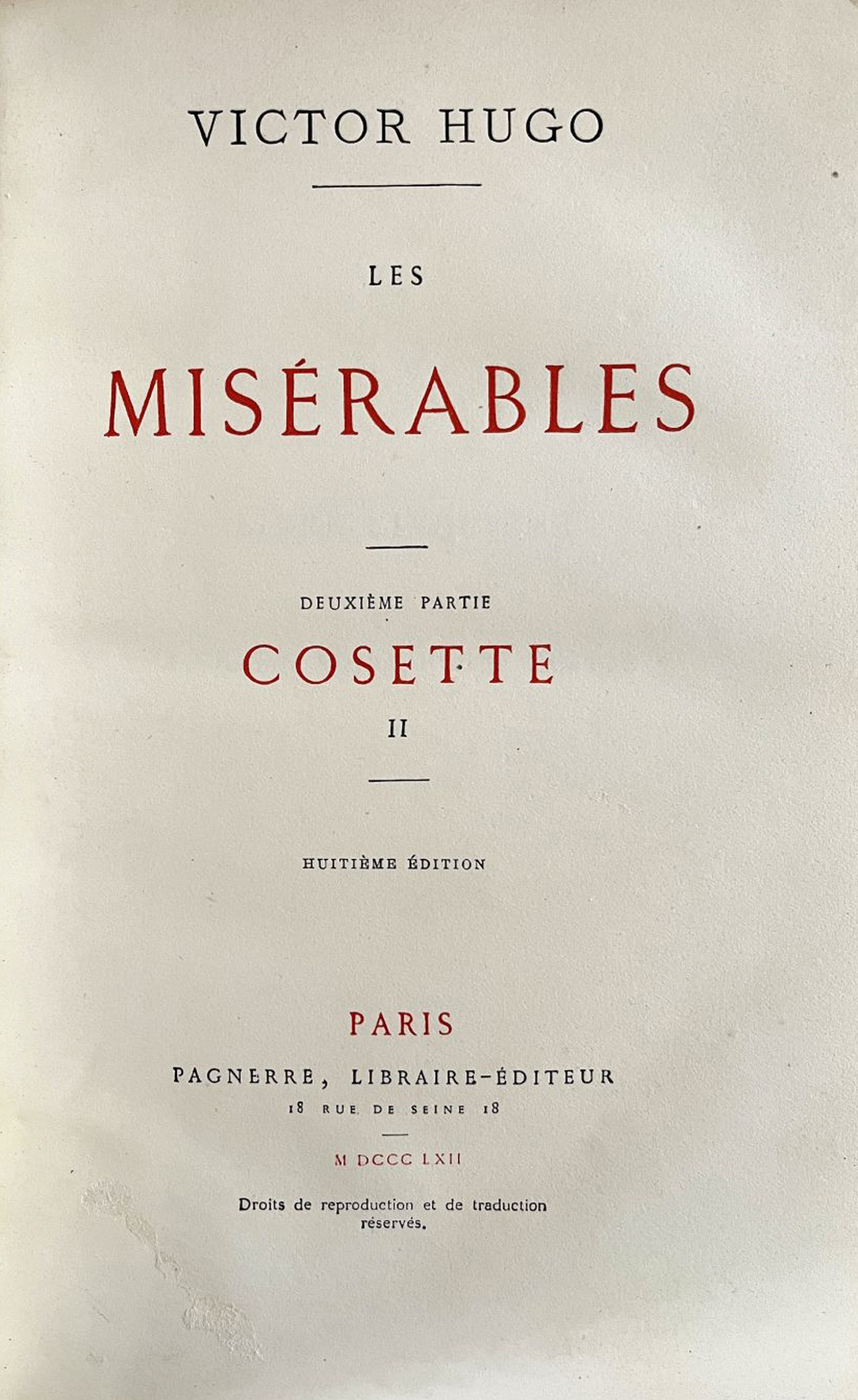
However, the concept of the first edition is not only a matter of date. Those who defend the Belgian theory highlight that it is to Brussels that the corrections of the proofs are sent and that, as Vicaire paradoxically affirms, Pagnerre is only the “custodian” of the genuine and sole publisher, Lacroix et Verboeckhoven & Cie.
From 1936, Georges Blaizot retorted in Le Bulletin du bibliophile that Pagnerre in no way took Lacroix's work on deposit, but that he “a véritablement établi, imprimé et vendu une édition des Misérables” “genuinely established, printed and sold an edition of Les Misérables”. Reducing Pagnerre to a territorial relay actually requires the complexity of the editorial affair of this major work to be ignored, the stake of which is not merely a financial matter for the exiled poet.
With Napoléon le Petit and Les Châtiments, Hugo demonstrated to the imperial power that the banishment of man in no way weakened the power of his word. On the contrary, this island exile could only echo that of an illustrious predecessor. The State's only weapon is therefore censorship. And it is the sword of Damocles that will henceforth control the publication strategies of Hugo and his publishers. In 1856, the publication of Les Contemplations was thus the dress rehearsal for Les Misérables: collaboration of publishers, simultaneous publication in France and in Belgium, only one correction of proofs... Hugo even thought of dividing the publication to dupe the censorship:
« La 1ère livraison paraît ; c'est le premier livre, Aurore, une géorgique, une bucolique, une églogue. On se jette dessus avec d'autant plus d'avidité qu'on craint que l'ouvrage ne soit interdit et que c'est presque du fruit défendu. Que fera le gouvernement ? Arrêtera-t-il cela ? quoi ! ce livre, Aurore : cette poésie fleur de mauve et rose tendre ? - il serait inouï, fabuleux, grotesque, ineffable de ridicule ; et en même temps que les frais de la tentative du côté des éditeurs seraient six fois moindres, l'odieux de l'instruction serait pour l'Empire dix fois plus grand. »
“The first delivery is published; it is the first book, Aurore, a georgic, a bucolic, an eclogue. We hurl ourselves on it with all the more greed given that we fear that the work will be forbidden and that it is almost forbidden fruit. What will the government do? Put a stop to it? What! this book, Aurore: this tender purple and pink flower poetry? – it would be incredible, fabulous, grotesque, outrageously ridiculous; and at the same time the cost of the attempt on the side of the publishers would be six times less, the unbearable instruction would be ten times greater for the Empire.”
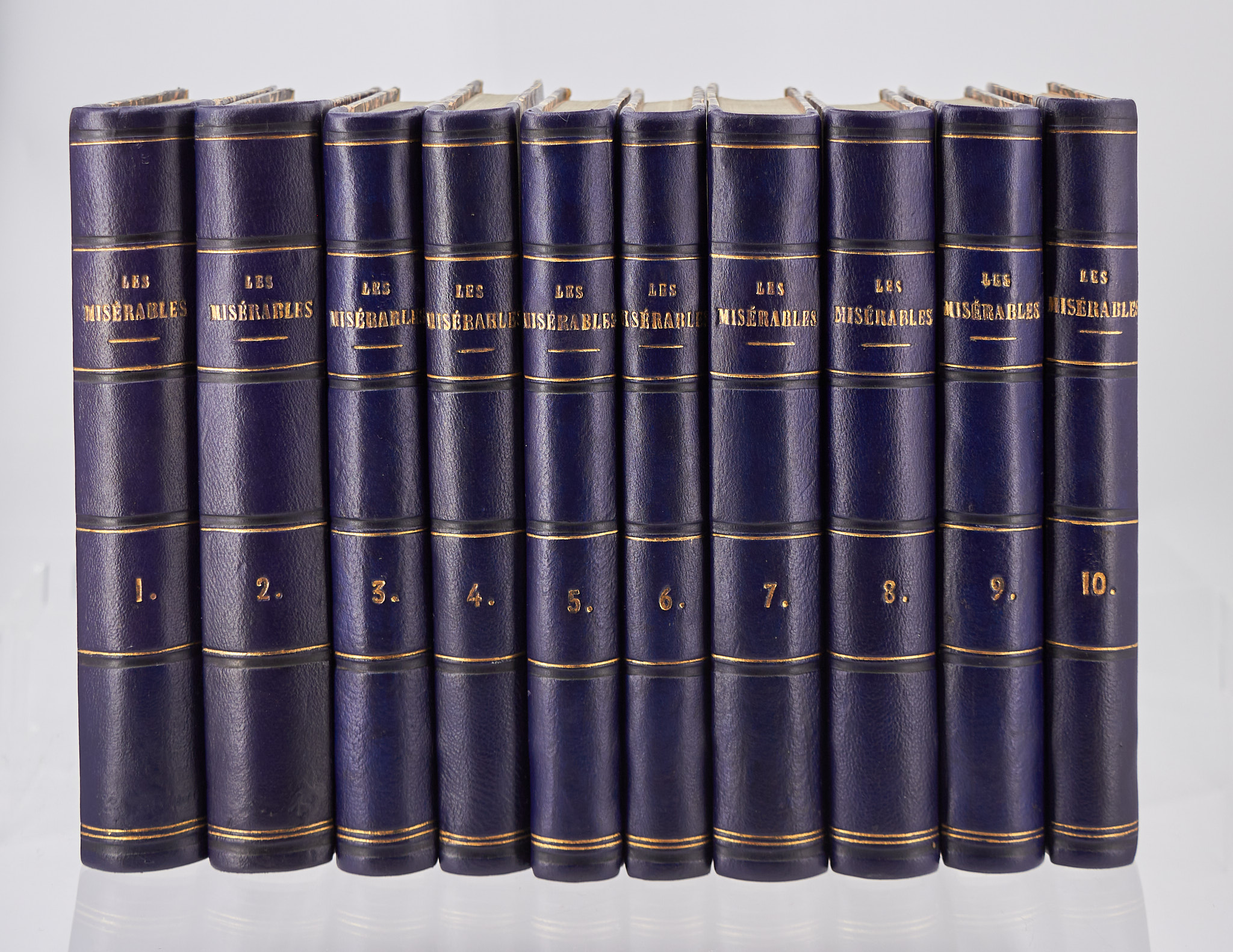
These precautions, undoubtedly unnecessary for the wise collection of poems that is Les Contemplations, will be the matrix of the publication of Les Misérables, a huge alarm call against the inequalities which could only fuel the anger of the Imperial Institution.
It was therefore necessary that Hugo's great work descend upon the world in one big wave. If censorship prevented the work from being published in Paris, it would come from everywhere else, and if the borders were closed, it would already be in the capital. Multiple printing, synchronisation and division of the work were the key to the success of this skilful game of cat and mouse. Added to this threat was the more mundane threat of counterfeiting that had to be taken aback. One month after the release of Fantine, the first two volumes of the novel, nearly ten pirate editions were circulating in Europe.
Albert Lacroix would have liked to undertake this epic alone and distribute his copies in France, as he did for the rest of the world. Hugo, despite Hetzel's insistence – who had been courting him for a long-time to obtain this Holy Grail – had explicitly chosen this unknown and inexperienced young Belgian publisher, to the detriment of his usual partners. Lacroix and Verboeckhoven are the only publishers and they make it known on every volume, Belgian or French. Thus, the title pages of the Parisian edition are inscribed “éditeur : Lacroix et Verboeckhoven & Cie” “Publisher: Lacroix et Verboeckhoven & Cie”. And La Revue Anecdotique comments: “L'édition française originale de Paris n'a été faite que pour éviter les formalités de douane.” “The first French edition from Paris was only made to avoid customs formalities.”
However, the reality is more complex and if Lacroix had not been able to impose its address at the foot of the title pages of the Parisian edition, it is because Pagnerre is not merely a relay of the Belgian publisher.
On the contrary, Pagnerre is, in fact, the first holder of the publication rights of Les Misérables.
Indeed, in 1832, Hugo signed a first agreement with the publisher of Notre-Dame de Paris, Gosselin, promising his next “roman en deux volumes in-8” “two-volume, in-8 novel”. Then in 1848, together they specified, by a new contract, the title of this novel: Les Misères “dont le rythme [d'écriture] est devenu celui d'une période d'achèvement” “whose [written] rhythm has become that of a period of completion” (Leuilliot, p.18). However, the revolution in 1848, then the poet's exile, put an end to the “ livre des Misères” “book of Misery”, the imminent publication of which Charles Hugo announced in L'événement on 31 July 1848. Thus, when twelve years later, Hugo resumed his work with these words: “14 février (1848) (ici le pair de France s'est interrompu, et le proscrit a continué :) 30 décembre 1860 Guernesey.” “14 February (1848) (here the peer of France is interrupted, and the outcast continued:) 30 December 1860 Guernsey.”, he is still linked to his former publisher, whose successor is none other than Laurent Pagneer.
The heir to the Gosselin-Renduel house is no stranger to Victor Hugo since he was one of the three associates (with Hetzel and Lévy) who published Les Contemplations and is still the publisher of Hugo's son, François-Victor.
Therefore, Victor Hugo sold his novel to Lacroix, provided that he negotiates with Pagnerre to purchase the rights to Gosselin and Renduel's successor. “J'ai vendu aujourd'hui Les Misérables à MM. A. Lacroix et Verboeckhoven et Cie, de Bruxelles, pour 12 années moyennant 240.000 fr. argent et 60 000 fr. éventuels. Ils acceptent le traité Gosselin-Renduel. Le contrat a été signé ce soir.” “Today I sold Les Misérables to Messieurs A. Lacroix and Verboeckhoven and Co. of Brussels for 12 years for 240,000 francs cash and a further potential 60,000 francs. They accept the Gosselin-Renduel agreement. The contract has been signed this evening.”. However, rather than sell his rights, Pagnerre preferred to exchange with Lacroix his 1832-1848 agreement for the exclusive distribution right in France.
The symbolic value of Pagnerre's edition does not in any way give way to that of Lacroix, and the Parisian publisher is linked to the very origins of the novel through its history.
As for the proofs, they were corrected on the Belgian print at Lacroix's will, despite Hugo's insistence: “Songez quel avantage il y aurait pour vous à m'envoyer les épreuves de l'édition de Paris” “Think of the benefit there would be for you in sending me the proofs to the Paris edition” (Letter to Lacroix on 12 January 1862). Even if Lacroix pretends to ignore this proposal, the fact remains that the right sheets must be sent to Meurice to perfect the work:
« Il importe que l'édition parisienne soit page à page et ligne à ligne identique à l'édition belge. La rapidité et la sûreté des corrections sont à ce prix, et de cette façon Meurice pourra donner les bons à tirer. Autrement, je serais obligé de demander la dernière épreuve de chaque feuille. »
“It is important that the Parisian edition be page by page, and line by line, identical to the Belgian edition. The speed and safety of the corrections are at this price, and in this way Meurice can send the goods to print. Otherwise, I would have to request the last proof of each sheet.”
Finally, an archive of the Victor Hugo collection tells us that the author had explicitly asked Lacroix about the proof of the title page with the two editions, Brussels and Paris, being placed facing each other on one common title page: “Je crois qu'il faudrait mettre sur deux colonnes en regard Paris Pagnerre | Bruxelles A. Lacroix en répétant cela sur la double édition de Paris” “I think that we should put Paris Pagnerre | Bruxelles A. Lacroix on two facing columns, repeating this on the Paris double edition”.
However, even if Lacroix did not (voluntarily?) accept the proposition (although he took into account the other corrections on the page), the meaning of this note is clear: for Hugo, there are not two editions, but only one, the printing of which had to be divided into two strategic places for reasons that were political (the risk of censorship of this masterful book), social (the international distribution of a work with universal scope) and economic (the risk of counterfeit of the greatest novel of the 19th century).
In 1936 Georges Blaizot concluded that the two editions were twin sisters. In that, he refuted the old rumour claiming that, in the Parisian edition, “un certain nombre de phrases ayant paru dangereuses pour la France, ont été modifiées” “a certain number of phrases that seemed dangerous to France have been changed” (Vicaire). This belief, however, is attributable to an unfortunate error by Victor Hugo himself who, on 24 December 1865, wrote to Verboeckhoven: “Il va sans dire encore que si un mot ou une ligne semblait dangereuse pour Paris, il faudrait l'éliminer, comme on a fait pour Les Misérables, édition Claye” “It goes without saying that if a word or a line seemed dangerous to Paris, it would have be eliminated, as was done for Les Misérables, Claye edition”. Yet Georges Blaizot highlights that this was an incorrect memory of Victor Hugo and that, thanks to careful rereading by Meurice and Vacquerie, who “tenaient avant tout à ce que l'édition de Paris ne fût pas inférieure à l'autre” “were above all concerned that the Paris edition was not inferior to the other”, there was no unilateral cut. “Victor Hugo aura ignoré ou oublié ce détail” “Victor Hugo will have ignored or forgotten that detail” (Dr Michaux quoted by G. Blaizot).
However, there are many differences (which escaped the attention of these bibliographers) between the two editions, but this was not to the detriment of the Parisian version, quite the contrary. It is indeed his best friend and factotum Paul Meurice, who, during Hugo's eighteen years of exile, was responsible for the publication, proofreading and corrections of Victor Hugo's works in France and, therefore, the Pagnerre edition of Les Misérables, on which the writer communicated his final, not light, but substantial, corrections. These corrections will also be sent to Lacroix, but too late, and the Belgian publisher warned Hugo that these will only appear in the second edition.
Thus, the Pagnerre edition was enriched with two modest but significant reflections that are lacking in the Brussels edition, in the important Waterloo chapter:
“ Le fond de ce prodigieux capitaine, c'était l'homme qui, dans le rapport au Directoire sur Aboukir, disait : Tel de nos boulets a tué six hommes ; Tel point du champ de bataille dévore plus de combattants que tel autre, comme ces sols plus ou moins spongieux qui boivent plus ou moins vite l'eau qu'on y jette. On est obligés de reverser là plus de soldats qu'on ne voudrait. Dépenses qui sont l'imprévu.” “The foundation of this wonderful captain was the man who, in the report to the Directory on Aboukir, said: Such a one of our balls killed six men; Such a point of the battlefield devours more fighters than another, as these more or less spongy soils that drink more or less quickly the water that we throw on to it. We are forced to give back more soldiers than we would like. Expenditure that was unexpected.”.
More than twin sisters, therefore, the two prints are one and the same editorial work that carries and embodies the ubiquity of their tremendous author.
Alone on his rock, and yet omnipresent, Hugo invades the public, poetic and political space with a universal romantic tragedy that crosses continents (no less that nine translations in progress from April 1862). A true slap in the face for the Empire Napoleon III, Victor Hugo's work immediately and irretrievably became a founding secular myth, illustrating the republican motto of 1848 and 1879: Liberté – égalité – Fraternité (Freedom, Equality, Fraternity).






![[Meidosems] Sans titre. Encre et aquarelle](media/crop1-h-177-w-165-michaux_henri_sans-titre-encre-et-aquarelle_1946_edition-originale_5_64945.jpg)





